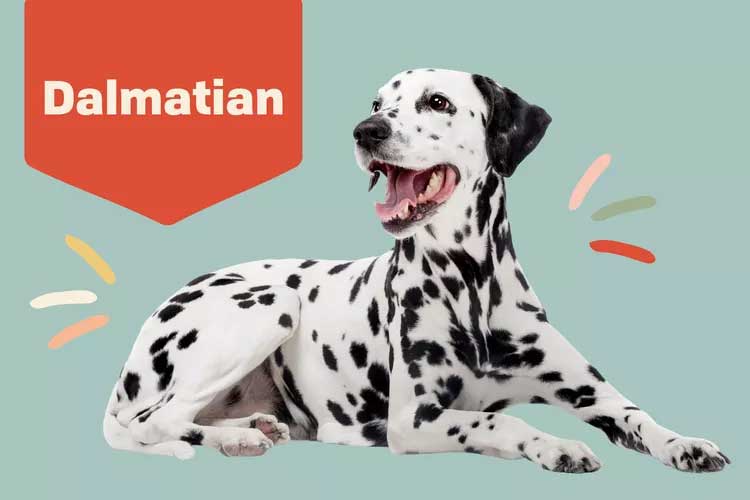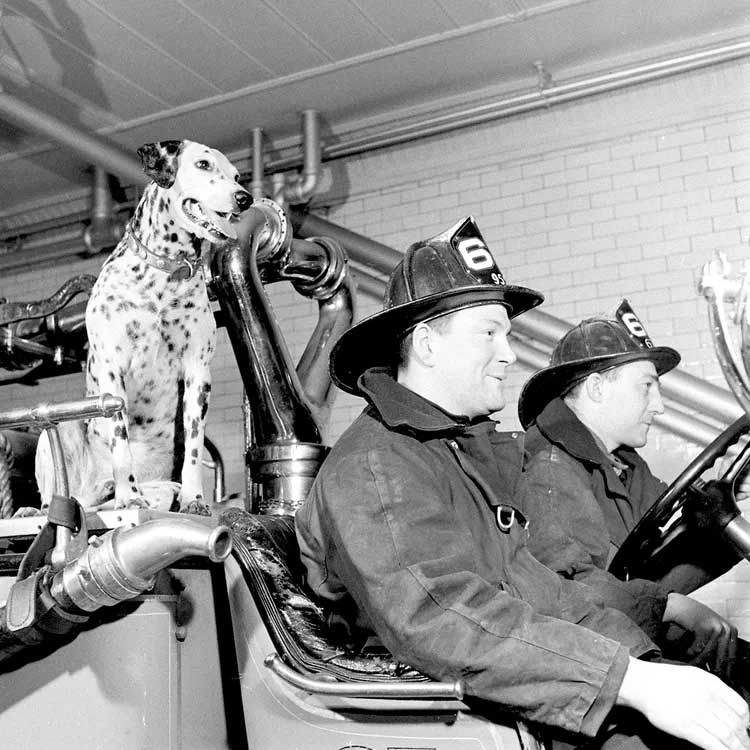With his spotted coat, the Dalmatian is one of the most instantly recognizable dogs in the world. His loyalty and playful personality make him perfect for most families.

Dalmatian Overview
| OFFICIAL NAME | Dalmatian |
| COMMON NAME | Dalmatian |
| PET HEIGHT | 19 to 24 inches |
| PET WEIGHT | 45 to 70 pounds |
| LIFESPAN | 11 to 13 years |
| GOOD WITH | cats, children, dogs, families |
| TEMPERAMENT | friendly, playful, timid |
| INTELLIGENCE | high |
| SHEDDING AMOUNT | frequent |
| EXERCISE NEEDS | high |
| ENERGY LEVEL | active |
| VOCAL LEVEL | infrequent |
| DROOL AMOUNT | medium |
| BREED GROUP | non-sporting |
| BREED SIZE | medium (26-60 lbs.) |
| COAT LENGTH | short |
| COLORS | black, brown / chocolate / liver, white |
| PATTERNS | spotted |
| OTHER TRAITS | easy to groom, easy to train, good hiking companion, high prey drive, hot weather tolerant, prone to health issues, strong loyalty tendencies |
Take one glance at his spotted coat and you'll instantly know: That's a Dalmatian. These dogs, affectionately called "Dals" for short, have a beautiful pattern that catches everyone's eye—and striking personalities to match.
Sweet, smart, and playful, Dalmatians are "all-around dogs," says John Cramer, president of the Heartland Dalmatian Club of Greater Kansas City. They've served many roles over the course of their long existence, including carriage dog, circus dog, and firehouse dog.
After building an impressive resume over the centuries, most Dalmatians are happy fulfilling today's most popular gig: Family dog. These pups are steadfastly loyal to their humans and thrive in active households that keep their muscular bodies moving, their sharp minds engaged, and their frequently shedding fur vacuumed up.
Appearance
Dals are one of the most instantly recognizable dog breeds, thanks to their short white coat that's covered in spots. While black and white is the most common color combination, liver Dalmatians can occur due to recessive genes inherited from the pup's parents. Rarely, you can find blue, brindle, and "lemon" Dalmatians with orange spots. Even rarer is a tricolor Dalmatian, which has black and tan spots. Sometimes you can find long-haired Dalmatians: Commonly called "long coat Dalmatians" or "LCs," this length is a rare trait also caused by recessive genes.
Though their coat is what makes them stand apart from the crowd, Dalmatian puppies are born sans-spots. Their distinctive pattern (which is unique to every Dal—no two are exactly alike!) starts showing up when they're around two weeks old.
Underneath those spots is a lean, muscular build. Dalmatians are on the larger end of medium-sized dog breeds, standing 19–24 inches and weighing 45–70 pounds when fully grown.
Temperament
Dals are highly intelligent and hard workers, but they can tend to be timid when confronted with anything new."Working with them early in life to expose them to lots of different situations can help considerably with [their shyness]," says Sarah Moore, DVM, Diplomate ACVIM (Neurology). "You will want to socialize them to all the different environments you will want them to be able to navigate calmly and comfortably later in life."

But once you get past that shy shell, Dals are total goofballs and have a silly sense of humor. They're remarkably loyal to their humans, and if you're diligent about exposing them to new people, new animals, and new situations in puppyhood, Dalmatians can do a complete 180 and become quite outgoing pups. Some Dals can be great therapy dogs as well.
Dalmatians are good family dogs and can get along well with children and other furry friends including cats and other dogs, if well-socialized. Again, socializing your Dalmatian puppy is key to helping him coexist with others.
"Because they can be nervous and wary of things they are not used to, introducing them to children as puppies is the surest way to make sure they will grow to become appropriate family dogs," Moore says. "Similar to children … they can get along great with other pets, but may be nervous or stressed and anxious around them if they are not introduced until adulthood."
Living Needs
Dalmatians thrive when they have a fenced-in yard to run around in. If they're cooped up indoors for too long, they can be prone to zoomies and might chew up some pillows. They'll be happiest with an active owner—if you're training for a marathon, a Dal is a great running partner! They could live in an apartment if taken for regular runs, brisk walks, or with daily games of frisbee in the park. Once their energy is spent, Dals will love spending the evening with some indoor playtime or just being close to their human.
"They'll attach to you," Cramer says. "If I'm sitting on the couch, they'll sit right next to me, sometimes put their head in my lap, sometimes just curl up at the end of the couch."
Because of their sensitive nature and how easily they can become bored, Dalmatians shouldn't be left alone for long periods of time, according to The Dalmatian Club of America. When you do leave your Dal alone—which should never be for more than a few hours at a time—make sure he has plenty of toys to keep him happy.
Because of their short coats, Dalmatians can do well in warmer climates, though you should never leave any dog outside in the heat. As a general rule: If you're hot, he's hot and should come inside. When taking your Dal for a winter walk, you might want to bundle him up in a coat or sweater.
Care
A common misconception is that because a Dalmatian's fur is so short, it's easy to manage. But that spotted coat sheds—a lot. Their coats are surprisingly dense and fur flies off year-round, covering your carpet, your furniture, and you in little prickly hairs. To curtail this (and to save serious money on lint rollers and vacuum bags), Cramer says you should brush your Dal at least once a week, preferably outside. The DCA recommends a bristle brush, rubber curry comb, or horsehair mitt. And, as with all breeds, incorporate regular nail trims and teeth brushing into your care routine.
Because of his history as a working dog, your Dalmatian will often greet you in the morning with a look that says, "what are we doing today?" He needs to keep his mind active and paws moving and would love to join you on long hikes, jogs, or bike rides. Dals are always down for a game of fetch, and regular play and daily walkies will keep him happy in between longer adventures. He also excels in dog sports including agility, rally, barn hunt, lure coursing, dock diving, and road trials with horses. If he doesn't get enough exercise, this typically quiet breed can become noisy and get into trouble as he tries to keep himself entertained.
"They want to go out and run and be active, so you'll want [to do] some kind of activity with them," Cramer says. "Don't think they're going to be a lap dog … but they can be a lot of fun."
Dalmatians wear their heart on their sleeves and take harsh words to heart. It's important to use positive reinforcement when training any breed, but especially when working with Dals. Moore says training with treats or clicker training can be particularly effective when it comes to teaching them obedience. Once he's mastered the basics of good behavior, this former circus dog will be ready to learn tricks—and quickly!

Health
As they're generally healthy dogs, Dalmatian lifespans are typically 11–13 years. But, as with all breeds, they are susceptible to a few health conditions.According to the Universities Federation for Animal Welfare, between 15–30 percent of Dalmatians are deaf in one ear, while 5 perfect are completely deaf. This is a condition detectable early in life, Moore says, so potential owners can preemptively learn about caring for a deaf dog before bringing home a Dalmatian puppy. Deaf dogs are still perfectly trainable and can be a loving companion for life. However, Cramer—who grew up with a deaf Dalmatian—says the deaf Dals might not do well in a home with small children, as they can be easily startled and spooked.
Along with deafness, Theresa Entriken, DVM, says Dalmatians may be predisposed to conditions such as:
Atopic dermatitis, a skin reaction caused by airborne or ingested allergens that results in excessive licking and scratching.
Kidney or bladder stones
Dilated cardiomyopathy, a serious condition in which the heart cannot effectively pump blood.
Bacterial folliculitis, an inflammatory skin condition caused by bacteria that can lead to hair loss.
Liver inflammation
Laryngeal paralysis and polyneuropathy, the degeneration of nerves in the throat.
Protein-losing enteropathy, where proteins are lost from the bloodstream into the gastrointestinal tract. This can cause fluid in the dog’s abdomen and/or diarrhea.
"This doesn't mean that a Dalmatian will experience one or more of these conditions during their lifetime," Entriken says. "And like any dog, they may experience another illness, so in general, pet parents should keep an eye out for behavior changes or other abnormalities in their pets and seek veterinary evaluation."
History
The Dalmatian is an ancient breed, and therefore his origins aren't as black-and-white as his fur. According to The DCA, ancient writings, engravings, and paintings have indicated the Dalmatian inhabited ancient Europe, Asia, and Africa. The first true identification comes from Dalmatia—hence the name "Dalmatian"—a historical province along the Adriatic Sea. But there's no actual evidence to prove Dalmatia is their homeland.
It's hard to know what the breed has more of: Spots or jobs. Dalmatians worked as English carriage dogs in the 17th century, running alongside horse-drawn carriages to protect travelers on the road. They also became staples in firehouses, running ahead and alongside fire trucks to clear the street of pedestrians. Other titles held by Dals include hunting dog, shepherd, watch dog, circus dog, and draft dog.
Today, Dalmatians are mostly retired family dogs, but still keep busy competing in many dog sports.
Fun Facts
In pop culture, Dalmatians are probably most associated with Disney’s 1961 movie One Hundred and One Dalmatians, about a family of pups who thwarts evil fashionista Cruella de Vil. There have since been a few remakes and spin-offs, including the 2021 film Cruella starring Emma Stone.Famous Dal owners include singer Paula Abdul, Casablanca star Ingrid Bergman, fashion designer Marc Jacobs, and Back to the Future star Michael J. Fox.
In a nod to their carriage dog history, Budweiser continues to use Dals as a mascot for their famous Clydesdales. But instead of running alongside the carriage, these pups have a front-row seat next to the driver.